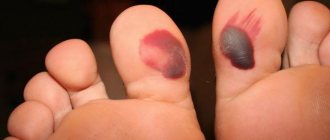The load that a woman's body experiences during pregnancy increases many times over. An increase in the weight of the fetus and uterus causes compression of the veins of the abdomen and pelvis, as a result of which the outflow of blood from the pelvic organs and lower extremities is disrupted. This leads to the development of swelling and varicose veins (varicose veins).
What are the dangers of varicose veins on the legs during pregnancy, what to do and how to relieve swelling during and after? High-quality and qualified information can only be obtained from a phlebologist
, because each case is individual and recommendations for treatment and prevention are given based on the specific situation.
Visually, varicose veins become noticeable when the veins become dilated in the form of blue nodes. Varicose veins (varicose veins and swelling in the legs) are observed not only in pregnant women. This disease is often diagnosed in other cases, but pregnancy can be one of the provoking reasons for the development of this disease. The risk of varicose veins is especially high after the birth of the second and third child, as well as with a hereditary predisposition.
Is swelling during pregnancy normal?
Rather yes than no. The key causes of edema during pregnancy are increased fluid in a woman's body and high levels of progesterone. This hormone begins to be actively produced during ovulation, preparing the uterus for egg implantation. Its concentration remains consistently high in a woman’s blood throughout pregnancy, providing many important functions related to fetal development. Unfortunately, it has this side effect.
Interesting fact
Many women notice swelling before menstruation. This is also progesterone. The level of the hormone increases in the second half of the menstrual cycle, which leads to this result.
The very fact that one of the causes of edema during pregnancy is the production of a very important hormone does not mean at all that you need to accept this situation with humility. It all depends on the severity of the condition: minor swelling in pregnant women is almost inevitable, but if it becomes significant, it is worth considering treatment.
Read here what other changes occur in the body during pregnancy.
Water accumulation and blood loss
Here’s another reason why you should endure the flood that pregnancy brings with it, and not prescribe dehydrating medications and diets: a woman will experience blood loss during childbirth. I'm not even talking about bleeding (although this happens), just normal blood loss, after which you will have to recover.
Now call on common sense to help: which woman will better tolerate blood loss and recover faster: the one who has a lot of blood, or the one who has little? The one that lost thick concentrated blood, or the one that lost diluted blood? Which one will lose more formed elements and nutrients?
A normally well-nourished and not dehydrated woman tolerates even significant blood loss surprisingly easily.
Where can swelling occur?
Swelling during pregnancy is most often localized in the feet, ankles and lower legs. The reasons are clear: excess liquid first collects at the very bottom - where gravity pulls it. Usually it all starts with pastosity - mild swelling with pallor and decreased elasticity of the skin.
The next favorite place for pastiness and swelling is the hands. Also, excess fluid often leaves a mark on the face; along with swelling, nasal congestion may appear - the so-called “rhinitis of pregnant women”.
It is important to know!
Most people consider drops and sprays for the common cold to be one of the most harmless medicines. Just not during pregnancy - many of them are dangerous for the fetus! Be sure to consult your doctor before treating a runny nose.
And even in the early stages of pregnancy, a woman’s body temperature rises to a level more comfortable for the fetus - just above 37 °C. This does not mean that you have a cold or a virus. To learn more about basal temperature, read our article.
How to detect swelling?
Severe swelling during pregnancy is difficult to miss. When swelling is not so obvious, especially if the accumulation of excess fluid occurs slowly, the following signs will help to detect it:
- Suspicious weight dynamics are observed. If you are following the diet recommended by your doctor, but your weekly weight gain exceeds the norm for this stage of pregnancy, most likely, water is retained somewhere in the body.
- The rings get stuck on the fingers and the shoes become tight. Signs of pastiness during pregnancy are most easily detected by things picked up by hand or leg - they begin to press. By the way, it’s better to remove the rings while you still have the opportunity.
- The face is rounded. Every day you see your face in the mirror and you will probably notice if its shape begins to blur and smooth out.
- Rubber marks remain. Many women today wear “sledki” - short socks that are almost invisible from their shoes. Perhaps the high “classic” is not so elegant, but it is an excellent means of early diagnosis of edema during pregnancy. If their elastic bands leave raised marks on the legs, it means that excess fluid is collecting in the tissues.
- Unusual sensations appear in the fingers. If you feel tingling, burning or numbness in your fingers, or if there is pain or tension when you flex your fingers or step on your toes, this is likely a sign of swelling.
Is swelling during pregnancy dangerous?
Edema is the excess accumulation of fluid in tissues. As you can see, in this definition there is no clarification “in the tissues located directly under the skin”; internal organs can also swell. Often, swelling of the arms, legs, and face in pregnant women is just the tip of the iceberg. Hidden from view, internal stagnation of water can cause organ dysfunction, general dehydration, and impaired oxygen transport. Ultimately, this may threaten the fetus with insufficient supply of nutrients and oxygen starvation. Severe swelling during pregnancy affects not only the beauty of the expectant mother, but also the health of her baby.
Medicine divides edema during pregnancy into physiological and pathological. The first refers to almost inevitable changes associated with hormonal shifts and a general increase in fluid circulating in the body. The latter are a sign of various internal problems, such as kidney disease, heart failure, varicose veins, gestosis (late toxicosis) and others. Physiological edema usually does not require treatment - to reduce it, it is enough to adhere to a healthy lifestyle. In case of pathological ones, it is necessary to find the cause and eliminate it.
Your doctor will be able to distinguish physiological edema from pathological edema based on the results of examination and tests. In particular, the presence of protein in the urine is an alarming sign. Between visits to the doctor, you yourself may suspect a pathology if the swelling grows too quickly, begins to rise above the legs, and when you press on the swollen areas, indentations remain on the skin, which slowly dissolve.
Pathological conditions
Physiological edema occurs in every pregnant woman and does not cause her any discomfort other than dissatisfaction with her appearance. You have to take off the rings and not wear them until the birth. Shoes are getting small, some women are buying boots and boots a size larger. This is a normal condition; all excess water is eliminated from the body on its own within a week after childbirth.
Preeclampsia is considered a pathology. Its first symptom is severe swelling of the lower leg, an increase in the volume of the leg by more than 1 cm per week.
Other symptoms of gestosis:
- protein in urine analysis;
- vomiting or nausea;
- high blood pressure;
- headache;
- convulsions.
There are several stages of gestosis; with regular visits to the antenatal clinic, doctors diagnose it at an early stage and immediately take action. If you do not visit a doctor and do not follow recommendations for the prevention of gestosis, this can lead to worsening of the condition, seizures and kidney failure.
Therefore, already in the early stages of gestosis, doctors recommend contacting an experienced obstetrician-gynecologist at the Gynecology Center. There they take measures to remove excess water and stimulate kidney function. If all else fails, an emergency caesarean section is performed. The baby is then nursed in an incubator, and the female body is helped to restore kidney function.
How to reduce swelling during pregnancy?
Treatment with pharmaceutical drugs is the last method, which is used only in extreme cases. Usually it is enough to adjust your lifestyle and acquire several useful habits. We will give you 12 simple recommendations that will help reduce water stagnation in the body.
- Follow a daily routine. Try not to get overtired during the day and get plenty of rest. The duration of sleep during pregnancy should be at least 8 hours, and, if your body has such a need, even 9–10 hours.
- Walk more. Your helpers in treating edema during pregnancy are fresh air and reasonable physical activity. If in ordinary life you are used to only walking from the elevator to the parked car and back, you need to do something about it.
- Wear comfortable shoes. Even if you really love high-heeled shoes, even if you feel embarrassed without them because of your own height, you will have to give them up for a while. Uncomfortable shoes aggravate swelling during pregnancy, and soft shoes with low heels help fight it. If your feet still hurt at the end of the day, visit an orthopedic salon and ask a specialist to make custom insoles for you.
- Change your position often. When your body becomes numb, it swells. Try not to sit or stand without moving for long periods of time. Both at work and at home, periodically leave your favorite chair to stretch a little. In the meantime, sit in it, do not freeze in one position - move your arms and legs, change your body position.
- Give your feet a rest. To prevent swelling in the legs, it is necessary to periodically raise them higher. This way you facilitate the work of the circulatory system and allow it to pump out some excess fluid from the legs. It's ideal to lie on your back with your legs up, but even if you just put them on the next chair during lunch in the corporate kitchen, that's not bad.
- Exercise. In the fight against swelling during pregnancy, simple physical exercises are useful - bending, turning, etc. Statics will also help: kneel down, then lower yourself onto your elbows, stand in this position for 5 minutes. Yoga classes for pregnant women also help to disperse fluid.
- Lie on your side. In the later stages of pregnancy, your body itself will tell you the correct position for rest - lying on your side. In the early stages, it is also the most useful: in this position, the kidneys work most efficiently, utilizing excess water.
- Drink, and don't limit yourself to it. You might think: the less I drink, the less swelling there will be. No, you can’t drive them away like that, and it’s easy to get dehydrated. Drink as much as you want, but only clean water, fruit drinks or decoctions without sugar. Soda, store-bought juices and other sugary drinks should be excluded from your diet.
- Maintain nutritional balance. During pregnancy, eat more protein foods, do not overindulge in pastries, bread, sweets and other carbohydrate-rich foods, and limit the amount of fat in your diet. Completely give up “empty calories” - snacks and fast food.
- Arrange fasting days. Give yourself diet therapy once a week. We're not talking about sitting just on the water all day. There are a lot of recipes for tasty and quite nutritious “unloading” - from a kefir or banana diet to a chicken breast day or fruit smoothies.
- Monitor your sodium intake. Sodium salts retain fluid in tissues, and the most famous of them is common table salt. To prevent severe edema during pregnancy, limit your daily salt intake to one level teaspoon, preferably even less. When making calculations, do not forget that salt enters the body not only from the salt shaker. It is found in many food ingredients (meat, fish, dairy products, tomatoes, etc.), and in almost all semi-finished and finished products - from sausage to bread. Over time, you may even come to love the natural taste of food with no or minimal added salt - it's quite good.
- Take natural diuretics. Rosehip, hawthorn, chamomile, lingonberry, bearberry - in the pharmacy you can find many natural remedies to combat swelling. Discuss your purchase with your doctor: During pregnancy, you should consult with your doctor before taking any medications, even herbal ones.
To prevent swelling and varicose veins, you can wear compression garments. Consult your doctor - he will tell you what is best to buy and how to use it.
If swelling disappears during pregnancy, is this good?
If you've recently changed your diet, spent more time outdoors, or taken other steps, that's a great thing. This means your treatments are working and you are on the right track.
It’s another matter when edema during pregnancy disappears on its own, without any changes in your life. A few days before the planned date of birth, this is normal: progesterone has done its job and its levels drop, releasing excess water. If childbirth is still far away, spontaneous reduction of edema is at least a suspicious sign. Contact your doctor so that he can determine the cause of the unexpected gift of the body and decide what to do about it.
Diagnostic stages
Consultation and examination by a therapist. After a detailed conversation and medical examination, the patient can be referred for consultation to other specialists depending on the etiology of the disease: cardiologist, allergist, endocrinologist, nephrologist, urologist, etc.
Laboratory research. First of all, the following are carried out:
- general (with leukocyte formula) and biochemical blood tests;
- general urine analysis.
- Instrumental studies:
- ECG;
- echocardiography;
- Ultrasound of blood vessels of the lower extremities;
- X-ray of the chest organs.
Next, the doctor prescribes a set of studies on an individual basis in each individual case.
To effectively eliminate swelling, you need to know exactly what disease is causing it. Edema is not an independent disease, but a symptom. Diagnostics using modern equipment will allow us to determine the cause of the pathology. The information obtained allows the doctor to choose the most effective treatment. Don't put off taking care of your health until later. Schedule a consultation with your doctor today to stay energized for years to come.
sign up for a consultation









